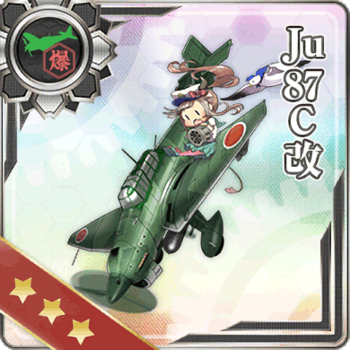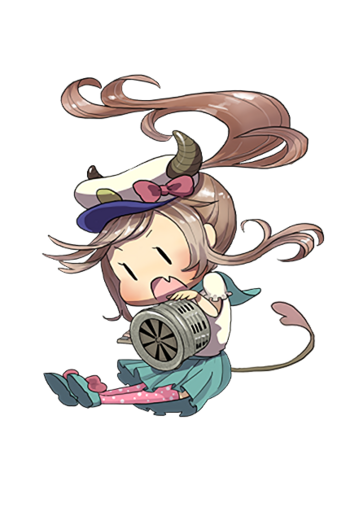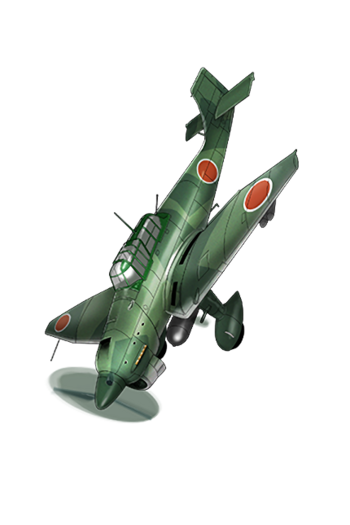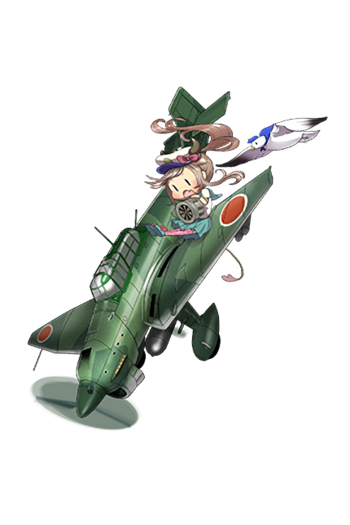- Welcome to the Kancolle Wiki!
- If you have any questions regarding site content, account registration, etc., please visit the KanColle Wiki Discord
Difference between revisions of "Ju 87C Kai"
>Saerav m (Added quest links.) |
Jigaraphale (talk | contribs) |
||
| (19 intermediate revisions by 8 users not shown) | |||
| Line 1: | Line 1: | ||
| − | {{ | + | {{Equipment|header=true}} |
| − | | | ||
| − | |||
| − | |||
| − | |||
| − | |||
| − | |||
| − | |||
| − | |||
| − | |||
| − | |||
| − | |||
| − | |||
| − | |||
| − | |||
| − | |||
| − | == | + | ==Mechanics== |
| − | + | {{Category:Carrier-based Dive Bombers}} | |
| − | + | {{Category:Anti-Installation Dive Bombers|equipment=true}} | |
| − | |||
| − | |||
| − | |||
| − | |||
==Notes== | ==Notes== | ||
| − | ''' | + | Not to be confused with other aircraft of this family (''see [[Stuka|here]]''). |
| − | + | ===How To Obtain=== | |
| + | '''Stock equipment of:''' {{Ship/Link|Graf Zeppelin Kai}} | ||
| − | + | '''From quest:''' {{Q|D6}}, {{Q|D7}} | |
| − | |||
| − | + | ''Ranking reward for:'' | |
| + | * Oct 2013: 1-3, 101-500 | ||
| − | + | ===Updates History=== | |
| + | * '''2013-11-01:''' Implemented | ||
| + | * '''2013-12-24:''' Stats increased: {{ASW}}+2 → {{ASW}}+5 | ||
| + | * '''2019-03-27:''' Ability to target [[Installation]]s added | ||
| + | {{clear}} | ||
| − | The | + | ==Trivia== |
| + | ;Historical Information | ||
| + | The '''Junkers Ju87C ''Sturzkampfflugzeug'''''<nowiki/>'' ''(''Dive Bomber'', literally "Falling Warplane", condensed to "Stuka") is a dive bomber developed in Germany and designed by Hermann Pohlmann who determined that any dive-bomber must be simple and robust. | ||
| − | + | After the Nazi Party came to power, design of a new bomber was prioritized by the German Aviation Ministry (RLM) which turned to the designs of Hermann Pohlmann of Junkers and the co-designer of the Junkers JuK47, Karl Plauth. Ernst Udet, an ace of the Luftwaffe, was a major proponent of the concept of dive-bombing after flying the American Curtiss ''HawkⅡ'', bringing dive bomber development to the fore of German aviation engineering. | |
| − | + | The JuK47 fighter was used as a testbed in 1932 for a number of experiments that would eventually become the Ju87, such as double vertical stabilizers. A JuA48 with a 600 hp BMW ''132'' engine and dive brakes was also tested, earning a positive evaluation. The Ju87's development began in earnest in 1933 as part of the ''Sturzbomber-Programm'', aiming to find a successor to the aging Heinkel He50. Initially, it was to be powered by a British Rolls-Royce ''Kestrel'' engine, of which ten were ordered. The prototype Ju87 was built in Sweden by AB Air Industry and delivered in secret to Germany in late 1934 though completion slipped from April 1935 to October 1935 due to the airframe's inadequate strength. | |
| − | + | The prototype Ju87A1, powered by a 515 hp ''Kestrel'' liquid-cooled V12 engine first flew in September 1935. However, it fatally crashed in January 1936 near Dresden killing Junkers' chief test pilot and his engineer. Investigation showed that the square twin-fins and rudders were too weak, collapsing under the stress induced by dive testing. This prompted a change to a single vertical stabilizer design and heavy plating with brackets were fitted to withstand the forces of a dive. Hydraulic dive brakes were among the other additions made at this phase. | |
| − | + | The RLM however was still uninterested in the Ju87 and did not like that its engine was British-sourced. Junkers suggested in 1935 to install a Daimler-Benz ''DB600'' engine until Junkers' ''Jumo 210'' engine was available, which was accepted by the RLM. The second prototype unit did not fly for a long time due to design problems and fears of poor stability. DB600 engines were also unavailable, so a BMW ''Hornet'' was substituted. Testing only resumed in late February 1935, and the Ju87A2 was finally fitted with a ''Jumo 210A'' in March 1936 and then a ''Jumo 210G'' a year later. | |
| − | + | Flight Captain Hesselbach praised its performance but Luftwaffe General Field Marshall Wolfram von Richthofen stated that it had little chance of becoming the Luftwaffe's principal dive bomber as it was underpowered. Development of the Ju87 was ordered canceled, but Ernst Udet rejected the order the next day, allowing Ju87 development to continue. | |
| − | Due to the ongoing war, the Ju87C was ultimately not produced beyond the testing phase as production switched to Ju87R1s. The "''Ju87C Kai''" of Kancolle appears to | + | Although it was ultimately chosen by Ernst Udet as the winner of the ''Sturzbomber-Programm'', it drew frequent criticism from Richthofen. Testing of a fourth prototype in early 1937 revealed a number of problems. Although it was capable of taking off with just 250 m of runway and able to climb to 1,875 m in eight minutes with a 250 kg bomb load, it was noted as being slower than the He 50 in acceleration. Pilots also complained of its unintuitive instrumentation, but praised its handling and strong airframe. Ultimately problems were resolved with the ''DB600 and Jumo 210'' engines, but it never met Richthofen's hopes of a 350 km/h+ top speed. |
| + | |||
| + | With its distinguishing inverse-gullwing design, the spatted undercarriage, and wailing sirens, the Stuka ultimately became the propaganda symbol of German air power. The Ju87's design included innovative features such as automatic pull-up dive brakes under both wings to allow the plane to recover from its attack dive even if the pilot blacked out from the forces. The Stuka, while sturdy and effective in its mission, was vulnerable to other aircraft and required heavy fighter escort to operate effectively. | ||
| + | |||
| + | The '''Ju87C''' in particular is a variant designed for use by the Kriegsmarine as a torpedo and dive bomber. Prototypes - Ju87B-0 airframes with ''Jumo 211A'' engines - were given two months of testing in February 1938. The Ju87C first flew in March due to delays but had problems with arresting gear. Eventually the "''Carrier Stuka"'' was cleared for production in 1940. "Special" equipment of the Ju87C included a two-seat rubber dinghy with signal ammunition and emergency ammunition for its pilots if they were forced to abandon the plane at sea. Other features include a quick-fuel dump mechanism and inflatable airbags in the fuselage and wings to allow it to float for up to three days in calm water. A Ju87C sub-type also had folding wings to reduce its footprint in carrier storage, but had problems. | ||
| + | |||
| + | Due to the ongoing war, the Ju87C was ultimately not produced beyond the testing phase as production switched to Ju87R1s. The "''Ju87C Kai''" of Kancolle appears to be a Japanese production design that was never realized in history. | ||
==See Also== | ==See Also== | ||
| − | |||
{{Equipmentlist}} | {{Equipmentlist}} | ||
| − | |||
Latest revision as of 09:21, 10 May 2024
[Edit]
No.64 Ju87C改
| |
| Refittable Ship Types | |
| Fast Battleship | Battleship |
| Aviation Battleship | Standard Aircraft Carrier |
| Armored Carrier | Light Carrier |
| Heavy Cruiser | Aviation Cruiser |
| Light Cruiser | Torpedo Cruiser |
| Training Cruiser | Destroyer |
| Coastal Defense Ship | Submarine |
| Aircraft Carrying Submarine | Seaplane Tender |
| Fleet Oiler | Submarine Tender |
| Repair Ship | Amphibious Assault Ship |
| LBAS Plane | |
Introduction
かの国の代表的な急降下爆撃機、その艦載機バージョン。
「スツーカ」という呼称が有名な、優れた急降下爆撃機性能を誇る、逆ガル式翼が特徴的な機体です。
急降下時の風切音がサイレンに似ていることから「悪魔のサイレン」とも呼ばれたそうです。
This is the carrier-based version of Germany's exemplary dive bomber.
Known as the "Stuka", this famous aircraft boasts excellent dive-bombing performance with its distinctive inverse gullwing design.
It is known as the "Siren of the Devil" due to the siren-like wind noise produced when it dives.
Mechanics
![]() Dive Bombers are one of the main types of plane used by CV(B/L). Their main role is to do damage during the Airstrike, with their "Dive Bombing"
Dive Bombers are one of the main types of plane used by CV(B/L). Their main role is to do damage during the Airstrike, with their "Dive Bombing" ![]() stat being the most important factor in this regard. Dive Bombers are additionally needed for dealing damage during day Shelling, especially for Aircraft Carrier Cut-Ins (CVCI).
stat being the most important factor in this regard. Dive Bombers are additionally needed for dealing damage during day Shelling, especially for Aircraft Carrier Cut-Ins (CVCI).
- They are vulnerable to shoot down during most Aerial Combat phases.
- They bring some accuracy bonus against PT boats.
- They cannot attack Installations unless they are Anti-Installation Dive Bombers.
This dive bomber has the ability to target installations during shelling.
Notes
Not to be confused with other aircraft of this family (see here).
How To Obtain
Stock equipment of: Graf Zeppelin Kai
Ranking reward for:
- Oct 2013: 1-3, 101-500
Updates History
- 2013-11-01: Implemented
- 2013-12-24: Stats increased:
 +2 →
+2 →  +5
+5 - 2019-03-27: Ability to target Installations added
Trivia
- Historical Information
The Junkers Ju87C Sturzkampfflugzeug (Dive Bomber, literally "Falling Warplane", condensed to "Stuka") is a dive bomber developed in Germany and designed by Hermann Pohlmann who determined that any dive-bomber must be simple and robust.
After the Nazi Party came to power, design of a new bomber was prioritized by the German Aviation Ministry (RLM) which turned to the designs of Hermann Pohlmann of Junkers and the co-designer of the Junkers JuK47, Karl Plauth. Ernst Udet, an ace of the Luftwaffe, was a major proponent of the concept of dive-bombing after flying the American Curtiss HawkⅡ, bringing dive bomber development to the fore of German aviation engineering.
The JuK47 fighter was used as a testbed in 1932 for a number of experiments that would eventually become the Ju87, such as double vertical stabilizers. A JuA48 with a 600 hp BMW 132 engine and dive brakes was also tested, earning a positive evaluation. The Ju87's development began in earnest in 1933 as part of the Sturzbomber-Programm, aiming to find a successor to the aging Heinkel He50. Initially, it was to be powered by a British Rolls-Royce Kestrel engine, of which ten were ordered. The prototype Ju87 was built in Sweden by AB Air Industry and delivered in secret to Germany in late 1934 though completion slipped from April 1935 to October 1935 due to the airframe's inadequate strength.
The prototype Ju87A1, powered by a 515 hp Kestrel liquid-cooled V12 engine first flew in September 1935. However, it fatally crashed in January 1936 near Dresden killing Junkers' chief test pilot and his engineer. Investigation showed that the square twin-fins and rudders were too weak, collapsing under the stress induced by dive testing. This prompted a change to a single vertical stabilizer design and heavy plating with brackets were fitted to withstand the forces of a dive. Hydraulic dive brakes were among the other additions made at this phase.
The RLM however was still uninterested in the Ju87 and did not like that its engine was British-sourced. Junkers suggested in 1935 to install a Daimler-Benz DB600 engine until Junkers' Jumo 210 engine was available, which was accepted by the RLM. The second prototype unit did not fly for a long time due to design problems and fears of poor stability. DB600 engines were also unavailable, so a BMW Hornet was substituted. Testing only resumed in late February 1935, and the Ju87A2 was finally fitted with a Jumo 210A in March 1936 and then a Jumo 210G a year later.
Flight Captain Hesselbach praised its performance but Luftwaffe General Field Marshall Wolfram von Richthofen stated that it had little chance of becoming the Luftwaffe's principal dive bomber as it was underpowered. Development of the Ju87 was ordered canceled, but Ernst Udet rejected the order the next day, allowing Ju87 development to continue.
Although it was ultimately chosen by Ernst Udet as the winner of the Sturzbomber-Programm, it drew frequent criticism from Richthofen. Testing of a fourth prototype in early 1937 revealed a number of problems. Although it was capable of taking off with just 250 m of runway and able to climb to 1,875 m in eight minutes with a 250 kg bomb load, it was noted as being slower than the He 50 in acceleration. Pilots also complained of its unintuitive instrumentation, but praised its handling and strong airframe. Ultimately problems were resolved with the DB600 and Jumo 210 engines, but it never met Richthofen's hopes of a 350 km/h+ top speed.
With its distinguishing inverse-gullwing design, the spatted undercarriage, and wailing sirens, the Stuka ultimately became the propaganda symbol of German air power. The Ju87's design included innovative features such as automatic pull-up dive brakes under both wings to allow the plane to recover from its attack dive even if the pilot blacked out from the forces. The Stuka, while sturdy and effective in its mission, was vulnerable to other aircraft and required heavy fighter escort to operate effectively.
The Ju87C in particular is a variant designed for use by the Kriegsmarine as a torpedo and dive bomber. Prototypes - Ju87B-0 airframes with Jumo 211A engines - were given two months of testing in February 1938. The Ju87C first flew in March due to delays but had problems with arresting gear. Eventually the "Carrier Stuka" was cleared for production in 1940. "Special" equipment of the Ju87C included a two-seat rubber dinghy with signal ammunition and emergency ammunition for its pilots if they were forced to abandon the plane at sea. Other features include a quick-fuel dump mechanism and inflatable airbags in the fuselage and wings to allow it to float for up to three days in calm water. A Ju87C sub-type also had folding wings to reduce its footprint in carrier storage, but had problems.
Due to the ongoing war, the Ju87C was ultimately not produced beyond the testing phase as production switched to Ju87R1s. The "Ju87C Kai" of Kancolle appears to be a Japanese production design that was never realized in history.



